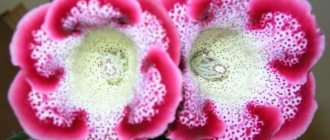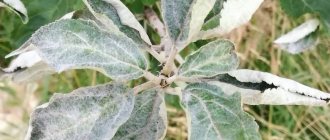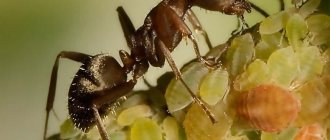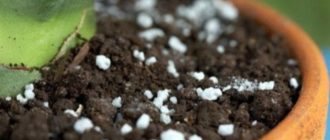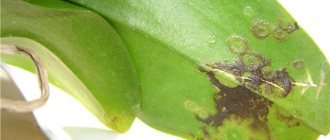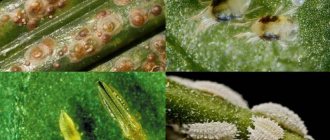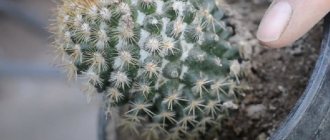Violets are popular and beautiful indoor plants. To grow Saintpaulias, you need to know what pests can affect them and how to deal with them.
The most dangerous and difficult parasites to remove are thrips: on violets they can go through all stages of development and cause irreparable harm to other indoor flowers.
What are thrips and how do they threaten plants?
Thrips are small insects that feed on plant sap. They go through 5 stages of development: from egg to adult. 1 female is capable of laying 1,000 eggs at a time. There are more than 2,000 species of these insects, and 360 of them live in the territory of the former USSR.
Adults have an oblong body and transparent wings. The size of the pests does not exceed 1-1.5 mm, but there are also smaller species of thrips that are more difficult to see. Parasites have different colors: black, gray, white, yellowish, etc.
The life cycle of insects is 35 days. They can develop in different conditions. For example, in the soil, on the surface of the plant or in its tissues, where the eggs are completely safe. Insects are capable of multiplying quickly, and this greatly complicates the fight against them.
Since pests feed on plant sap and tissue, they are capable of destroying a completely healthy flower in a short time. The larvae open the anthers on the peduncles, and the adults bite through the flower tissue and suck out the nutrients.
In addition, insects also attack vegetable crops, since they reproduce throughout the year. When growing seedlings on a windowsill, it is important to prevent them from multiplying.
Sawflies
Spruce trees are attacked by sawflies:
- Canadian,
- Serbian,
- European,
- occasionally prickly.
As a rule, spruce trees do not suffer much from these parasites; next year their needles are restored. Sawflies cause more damage to pine trees; sometimes you can find entire nests of insects on the branches. Weymouth pine, cedar, mountain and common pine are most often attacked.
The insect's abdomen is connected to the thorax motionlessly, without the help of a stalk. The ovipositor of females looks like a saw, with which they cut plant tissue and lay eggs inside.
Externally, sawfly larvae look like caterpillars.
It is they who eat young shoots of coniferous plants from May to the end of June, after which the branches look scorched and die.
Controlling these pests is not difficult. The main task is to see the caterpillars in time and take measures to destroy them. “BI-58”, “Aktellik”, “Decis” and “Fury” will help with this.
How to recognize that a violet is infected with thrips
Since thrips are one of the most common problems, you need to know and be able to recognize the main signs of their parasitism on Saintpaulias:
- pollen is actively falling off on flowers;
- the leaves begin to curl and lose their elasticity;
- white or gray blotches and spots appear on the leaf plate;
- the buds fade before they have time to open, and the flowers wither and darken;
- a sticky coating forms on the surface of the plant;
- the leaves darken and fall off.
Some of the signs above may indicate other problems. Therefore, if similar symptoms and signs appear, you need to carefully examine the violet from all sides. This will allow you to detect either adults or their larvae.
General signs of damage
As noted, there are several types of mites on violets. Each of them damages the plant in its own way. But we can identify several general signs that unmistakably indicate the presence of these pests:
- If the central leaves in the rosette of the flower twist, become fragile and stop growing, then these are clear signs of Saintpaulia being affected by the cyclamen mite.
- In the presence of tarzonemids (another type of mite), the pollen becomes too loose and falls onto the flower petals.
- Different types of mites lay clutches of eggs on leaves: through a magnifying glass, it is easy to see roughness and compactions on the leaves; they can also be felt with your fingers.
- The leaves of violets infected with mites are more pubescent.
- The color of the leaves changes - they noticeably fade, look as if sprinkled with flour or ash, and may become brownish-gray. In this case, the stem is made significantly shorter. Based on these signs, a conclusion is drawn about the presence of cyclamen, strawberry and other mites.
- All types of mites significantly deplete the plant. The leaves and stems of the affected violet quickly break.
- When affected by tarzonemids, Saintpaulia becomes weak, loses buds and stops blooming.
- The presence of any mites will be indicated by the leaf of the plant: a large number of small light spots appear on it - these are places where the mite has bitten the leaf plate. The stronger the damage, the more such points there are.
Under a microscope
Fighting methods
Thrips are quite difficult to remove, therefore, having noticed them, it is necessary to immediately begin violet treatment. To kill insects, they use special pesticides designed to combat persistent parasites on plants, and these are pests on violets such as mites, thrips, scale insects, etc.
For highly effective treatment, flower growers recommend using a set of measures to destroy and prevent thrips. Control methods include the following mandatory actions:
- The first thing to do is to identify the infected flowers and isolate them from healthy Saintpaulias by moving them to another room.
- If the plant has flower stalks, it is advisable to cut them off and dispose of them, since the pest larvae often live in flowers and buds.
- Before starting chemical treatment, the violet must be washed under warm water.
- The chemical should be diluted according to the instructions and, taking all precautions, spray the plant with a spray bottle.
- After systematic treatment, it is necessary to carry out the usual care for violets, but the violets should be placed in another room until there is complete confidence that the pests have been exterminated.
This type of insect is resistant to various chemicals. This is due to the fact that people do not completely poison the parasites, which survive and subsequently become resistant to one or another drug.
Flower growers recommend systematically poisoning thrips for 1 month. During this time, those larvae that were safe at the time of chemical treatment may degenerate.
In pest control, non-standard approaches are often used. For example, use a solution of zoo shampoo and water.
Green soap
A popular remedy for pests is the insecticide green soap. It is produced on the basis of potassium salt of fatty acids and has a contact effect.
The drug will help exterminate the parasites living on Saintpaulias; green soap can be used in its pure form, diluted and mixed with other chemicals.
During processing, the active substance forms a film on the insect’s body that envelops it and blocks the respiratory tract.
To work with the insecticide, you must use only glass or porcelain containers.
Dimetris
Many methods of pest control, including thrips, can be found on the page of the Dimetris flower growing community. They have a whole section with information dedicated to combating parasites and other diseases of violets.
Saintpaulia treatment must be carried out not only systematically, but also by changing preparations. It is recommended to choose flower treatment products with different active ingredients. It is believed that this approach will increase the effectiveness of pest control.
Other drugs
A popular drug for pest control is Aktara. Thrips can develop resistance to the active substance over time, so gardeners recommend treating with a concentrated solution of the product.
In combination or separately, such drugs as Fitoverm, Vertimek, Confidor, Tanrek, Agravertin, etc. are used.
Violet RS-Emerald City (S. Repkina)
RS-Emerald City, RS-Izumrudnyy Gorod (S. Repkina).
The variety RS - Emerald City (S. Repkina), holds a special place in Saintpaulia collections , it is admired for:
- Unusual color;
- And long flowering.
The Emerald City variety got its name in honor of the fictional fairy-tale city of the same name, located in the magical land of Oz.
Violet RS-Emerald City with a magical color transition. Flowers:
- Semi-double, similar to a moth in flight;
- White-green color;
- They have a lilac-blue darkening towards the edge of the petals, and a very wide green border with emerald fringe, almost light green in color.
According to the classification, the variety belongs to the standard class . As Saintpaulia lovers note, the longer the flowers last, the greater the color contrast they have. The variety blooms almost without interruption.
The size of the flowers of an adult violet is about 6-7 cm. The leaves of this variety are medium green, corrugated without variegation .
Attention! The rosette of a violet in an adult plant is from 20 cm to 40 cm and, despite the wavy leaves, is very neat.
How to avoid thrips
The most effective method of controlling any pests is prevention. In order to prevent the appearance of thrips, it is recommended to follow simple preventive measures:
- Do not allow excessive dry air in the room where the flowers are placed.
- During treatment and in the summer, periodically bathe Saintpaulia under running warm water.
- Place all new indoor plants in another room for quarantine (about a month), and place vases with bouquets away from violets.
- Inspect Saintpaulias regularly, paying close attention to the undersides of the leaves and the middle of the flowers.
If you find pests on your favorite flowers, there is no need to worry, but it is better to immediately begin treatment. It is imperative to systematically treat sick Saintpaulias at least 5 times every 5-7 days.
Reviews
Anna. A new variety for me. It’s just starting to bloom and immediately captivated me with its incredible coloring. The flowers are simply amazing. The color transitions are magical, the flower shape is original, it looks like an exotic butterfly in flight. The leaves, although corrugated, are nice to be arranged into a rosette. Even without forming a rosette, it looks very neat.
The delicate violet attracts many gardeners.
Olga. A very impressive, cool violet. Huge flowers, about 6 cm, with a green ruffle along the edge. It blooms almost without interruption. The variety is not very stable when propagated from five children; only three have flowered according to the variety. And the two turned out to have slightly different flowering options.
Khrushchev or May beetle - double pest
The cockchafer (Melolontha) is a large polyphagous pest. The body length of an adult insect reaches 3.5-4.0 cm. The body of the cockchafer is light brown or brownish-brown in color. The flight and reproduction of the cockchafer begins approximately in the second ten days of May. From the eggs, after 1.0-1.5 months, large white larvae hatch with a black head equipped with an oral gnawing apparatus. Their white, segmented body is coiled into a fetal shape.
The cockchafer larva lives and feeds in the soil for 3-4 years. By the end of the summer of the 4th year, an adult beetle emerges from the pupa and remains in the soil until spring. In the spring, appearing on the surface of the earth, the imago begins to feed intensively. During this period, the cockchafer is the most dangerous pest, since the larvae in the soil damage the root system, while the beetles on the surface damage the flowers and vegetative mass.
Danger level of the cockchafer
Under favorable conditions, the number of cockchafers increases significantly and quickly. The threshold of harmfulness of the cockchafer is 1 larva per 1 sq. m area. Currently, in some regions the presence of 2-3, and near forest belts, up to 20 or more larvae per square meter is recorded. m. Thus, the threshold of harmfulness has been exceeded many times, i.e. we can talk about epiphytotic reproduction of the cockchafer.
What crops are affected by the cockchafer and its larvae?
The cockchafer is a polyphagous and particularly dangerous pest. Adults and larvae damage plants. Adult chafers feed on leaves, flowers and ovaries of all fruit and ornamental trees and shrubs during the flight and breeding season (about 1-2 months a year, mainly in spring).
The larvae of the cockchafer gnaw at the roots of strawberries/strawberries, black and other types of currants, cherries, pears, apple trees (they especially like them), aspen, birch, cedar, spruce and other plants. Moreover, the appetite of the larvae of this pest increases with age. Currently, there is a 10-year period of activity in the intensive reproduction of the Khrushchev and its flights to new places. Right now it is necessary to take all measures to protect plants and destroy the pest.
Signs of plant damage by the cockchafer
In plants damaged by an adult cockchafer, leaf blades, buds, partially ovaries and young needles on conifers are eaten away. When the roots are damaged by the larvae, the plant lags behind in development, withers, and is easily pulled out of the soil.
Agrotechnical
- May beetles and their larvae cannot tolerate the smell and secretion of lupine, or the presence of nitrogen compounds in the soil. By sowing white clover, peas and other nitrogen-fixing crops under tree trunks or sowing green manure from mustard and cruciferous vegetables, you can significantly reduce the number of cockchafer larvae per unit area of land.
- During the mass flight (end of April - May) in the mornings at temperatures no higher than +12..+15°C), shake the branches and collect cockchafers.
- Mulching the soil with fine mulch in the form of shavings, crushed bark, chopped straw, chopped elderberry branches, chopped lupine, various cruciferous vegetables, even cabbage leaves.
Chemical
The following chemical preparations are recommended specifically for cockchafer larvae.
- Pochin and Zemlin, Aktara, Bazudin, Vallar are contact-intestinal insecticides.
- Antikhrushch is a modern environmentally friendly drug that has a long-lasting effect on the pest.
- Among the harmless chemicals, ammonia water solution can be used to destroy cockchafer larvae.
Biological
- Nemabact, developed on the basis of a soil nematode. The biological product maintains a positive balance of pests in the soil for more than 2 years. Kills the pest within 3 days.
- Biological products Actofit, Boverin, Fitoverm effectively destroy cockchafer larvae. Before use, be sure to read the recommendations.
Aphids
Aphids are microscopic insects whose body size does not exceed 2 mm. Moreover, they can be either with wings or without them. The body of the aphid is very soft and the parasite can be easily crushed with your fingers. They reproduce very quickly - approximately 150 larvae are born every two weeks.
Symptoms
Aphids can be detected with the naked eye. Most often they accumulate on the underside of leaf blades and plant buds. When infected by these pests, the apical part of the violet is deformed, the leaves curl, the buds lag behind in growth, and the flowers change shape. At the same time, the foliage becomes covered with sweet honeydew, on which sooty fungus subsequently develops.
On a note! Usually aphids appear where violets are not given proper care!
Treatment
Since aphids reproduce quickly, it is necessary to combat them on violets immediately. The activities are as follows:
- we collect insects by hand - this may be quite enough if the infestation is minor;
- cut off the affected leaves and buds;
- we wash the violet with a solution of laundry soap - this is necessary in order to remove the remaining individuals and their larvae;
- after the “water procedures” we treat the flower with the preparation “Actellik”, “Fitoverm”, “Intavir” or “Monoplan”;
- a week later we repeat the treatment.
Advice! If there are ants in the house, then you also need to get rid of them, as they contribute to the spread of aphids.
There is also a very effective folk recipe for aphids on violets. To prepare it, you need to combine 50 g of onion peels, a teaspoon of crushed garlic and 50 g of tomato tops in half a liter of water. After a day of infusion, we filter the product and treat the infected plants. If there are a lot of aphids, then the violet should be completely immersed in the resulting preparation.
Enemies of bees among animals
Among the animals there are also bee pests that eat honey and destroy hives.
Rodents
Different types of rodents can be potential bee pests. In the fall, mice and shrews enter the hives and can live there all winter, feeding on larvae, honey, and beebread.
Mice - no matter whether forest, house or field mice - harm the bee colony by settling in its house. The bees themselves cannot tolerate the mouse smell, and therefore will not live in a hive where mice lived
Expert opinion Dmitry Filipovich Smirnov Experienced beekeeper who knows everything about honey and the life of bees
To prevent rodents from disturbing the bees, there should be no unnecessary cracks in the hives, and the entrances should be small.
To prevent mice from gnawing on the honeycombs and destroying the hive, traps are placed on them, and poisoned bait is placed in the wintering room.
Jerzy
Although seemingly harmless, hedgehogs can also be pests. At night, when all the bees are resting, hedgehogs enter the hives, feeding on dead bodies and healthy insects. Hedgehogs cannot be killed; they are not considered major pests of the national economy. The only method of combating hedgehogs may be to install houses at a height of more than 35 cm above the ground and create good ventilation in the hive so that the bees do not go to the flying grounds, where the hunter-hedgehog will be waiting for them.
Reptiles
The harm from frogs caused by eating bees is insignificant compared to the benefits they bring by hunting various insects. Therefore they are not considered pests. And no special measures have been invented to combat frogs. You just need to install the apiary away from water in a well-lit area and on high stands.
But lizards and toads feel great in the apiary, deftly hunting beekeeping workers who are heavy with their burdens, and are considered pests. A lizard can catch 15-20 insects per day, and a toad even more. The beekeeper should not kill these animals. By going around the apiary, he can catch the lizard and take it away from the hives. She won't be able to find her way back.

